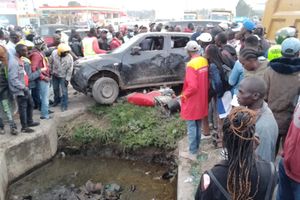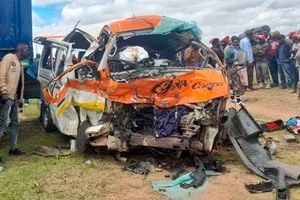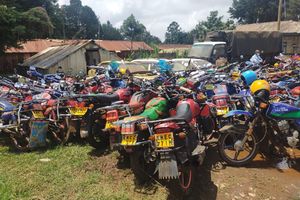
Boda boda riders waiting to pick passengers on the streets of Nairobi.
One in three Kenyans who died in road accidents over the past six years was either on a motorcycle or hit by the two-wheeled speed machines that dot the country's roads and footpaths.
Together, motorcyclists and pillion passengers accounted for 8,432 of the 24,312 road accident deaths reported between 2018 and 2023, according to data on road accidents in the country.
About 70,000 road accidents occurred in the country in the last decade, leaving a trail of misery in many households. The lives of more than 120,000 Kenyans who were left with injuries were changed forever.
Between 2014 and 2023, more than 36,000 lives were lost in road crashes, taking parents, siblings and friends with them.

Motorbikes belonging to boda boda operators
People who left home thinking they were on their way home found themselves on their last journey.
As road crashes continue to rob families across the country of their loved ones and leave thousands with trauma they'll take to their graves, one group of road users most at risk of dying on the roads are motorcyclists, who account for a third of reported road deaths.
The killer boda bodas have grown exponentially over the past two decades, taking up a huge share of Kenya's informal economy and employing hundreds of thousands of young people in every corner of the country.
But authorities say road accidents involving motorcyclists and pedestrians are approaching a tipping point.
The National Transport and Safety Authority (NTSA) noted in its 2023-2027 National Road Safety Action Plan that "some hospitals now have a special ward for victims of motorcycle accidents, and 80 per cent of patients at the Spinal Injury Hospital are victims of road accidents.
The boda boda industry is an important part of Kenya's economy, providing a viable alternative to work for a large proportion of Kenya's youth.
They allow Kenyans to reach remote corners where conventional vehicles can't go. However, a mix of factors has turned the boda boda industry into something of a jungle.
The roughness with which they operate on the roads increases the risk of freak accidents, and the sector is vulnerable to exploitation by criminals.

A motorbike rider involved in an accident on Ngong Road, Nairobi, on May 31, 2022.
On the streets of Nairobi city, motorcyclists flout the rules of the road. They speed aggressively in the wrong lane, disregard traffic lights and cross footpaths in full view of traffic police.
In various parts of the country, boda bodas carrying excessive numbers of passengers and huge loads, endangering themselves and other road users, are a common sight.
The cost of this notoriety, data now shows, has been many deaths and injuries. Some 219 motorcyclists and passengers were killed in road crashes in the first seven weeks of this year. That was a third of the 649 road deaths reported in the year to 20 February, according to the NTSA.
"Another important objective is to establish effective regulatory control over boda boda (motorcycle taxi) safety and to develop a long-term motorcycle safety plan. This will help address the specific risks associated with motorcycles and ensure their safe operation," the NTSA said in its road safety action plan.
In a proposed motorcycle safety plan, the authority has recommended tougher consequences for motorcyclists who break the law "to reverse the gross violations that kill and maim so many Kenyans".
Pedestrians have been the biggest victims of road accidents in the past decade, accounting for 36.2 per cent of reported deaths, data shows.
This has been the unintended consequence of the extensive road infrastructure in which the country has invested heavily.
While intended to facilitate the movement of people and goods to drive economic growth, the smooth roads have become death traps, claiming lives on an almost daily basis and causing untold economic losses.

Boda boda riders sit idle on their motorcycles in Nairobi on May 26, 2021.
Data shows that of the 1.7 million Kenyans who will die in the country between 2014 and 2023, 36,160 will die in road accidents.
However, the World Health Organization (WHO) estimates that the number of road deaths could be four times higher.
In 2022, 4,690 of the 213,210 Kenyans who lost their lives were killed in road crashes, meaning that for every 45 Kenyans who died that year, one died in a road crash, a trend that is worse than the decade average of one in 50 deaths in Kenya.
In the seven weeks to February 20, 2024, 649 people died on the roads, a weekly average of 92 road crash deaths, higher than the weekly average of 83 road crash deaths in 2023.
As roads have opened up to even the remotest Kenyan villages, so has the number of deaths. The NTSA was established more than 10 years ago to enforce road safety.
Despite its existence since 2012, the number of Kenyans dying on the roads has increased by around two-thirds in the past decade, approaching 5,000 deaths per year.
In its 2023-2027 National Road Safety Action Plan, the authority attributes the rise in road crashes to a rapid increase in human and vehicle population, "which in turn has led to a rapid increase in traffic".
"The entire road transport system in Kenya cannot cope in its current state, resulting in a very high number of deaths and serious injuries.
"The current road safety situation is worrying, especially with a rapidly growing vehicle fleet. Vulnerable road users, in particular pedestrians and motorcyclists, are most at risk. Therefore, the safety of pedestrians and motorcyclists (and pillion riders) is a major and ongoing concern and the road environment needs to be made much safer for them," the NTSA said.
Responding to questions from the Nation as to why Kenyans continue to die in road accidents despite the existence of regulations on seat belt use, speed limits, vehicle inspection and control of the number of passengers in public service vehicles, the NTSA says this is due to an incomplete speed and traffic violation management system, noting that it is "at an advanced stage of developing and implementing the speed and traffic violation management system" and that once completed, "it will bring all PSVs and PSVs into our real time span of monitoring".
The NTSA also says that it relies on the cooperation of stakeholders in the transport sector to ensure that speed limiters are working properly and that some drivers are not complying with traffic rules on speed and lane discipline.
The authority also relies on transport operators "to ensure that their vehicles are inspected to ensure that they are roadworthy and that speed limiters are not tampered with after inspection".
It says it has carried out road safety audits and mapping of black spots, the results of which have informed decisions such as the segregation of lanes in Sachangwan, Nakuru County.
On paper, the NTSA has a plan to halve the number of road deaths from the current 4,690 by 2022, but this could be a tall order given the challenges it faces.
Pedestrians have always made up the majority of people killed in road accidents, more than motorcyclists and pillion riders combined.
"This is a culture that the authority is constantly working to eliminate. The majority of pedestrians are unaware of road safety and engage in risky behaviours such as walking in the middle of the road, crossing in undesignated areas and not using footbridges," NTSA told the Nation.
The authority says video data it collected at 38 black spots in Nairobi showed that less than a quarter of Nairobians use designated pedestrian crossings, even where they exist.
In November 2020, the Auditor General released a performance audit on road infrastructure maintenance that revealed glaring gaps in road design and safety considerations during construction and maintenance, which could have contributed to most of the road accidents witnessed.
The audit found that on most roads across the country, road signs had been abandoned, vandalised, or not taken into account during construction and that some sections of roads with steep slopes and points lacked guardrails.
"During the physical inspection of road furniture on the sampled roads between January and March 2019, it was found that various warning signs for bumps, curves and pedestrian crossings were missing at critical locations. Analysis of the data collected during the inspection of the sampled roads shows that of the 459 road bumps recorded, 254 had signage while 205 had no signs to warn motorists," the audit said.
"The absence of this critical road furniture poses a safety risk to road users. The absence of safety barriers, such as crash barriers, provides limited or no protection to road users. In addition, the absence of markings in areas where traffic is expected to slow down exposes road users to the risk of collision or pedestrians being knocked down as they approach the bus bay. Ultimately, there is an increased likelihood of road casualties and deaths that could have been avoided," the audit concluded.
Some of the roads with the highest number of vandalised street furniture, the audit found, were those with the highest number of fatal crashes, including the Gilgil-Mau Summit, Machakos-Kitui and Mariakani-Kaloleni-Mavueni roads.
The audit followed some of the worst road crashes witnessed on Kenya's roads, including two that claimed 95 lives, and acknowledged that road accidents were partly caused by the absence or inappropriate placement of road furniture. At the time, the National Police Service had listed 78 roads as black spots.
"It is alarming that lives are lost when the installation of appropriate furniture could have prevented the accidents to a large extent," said the Auditor-General lamented, noting that the government had spent Sh150 billion in four years, some of which could have been used to improve road safety.
NTSA records show that fatal road crashes are concentrated on certain roads and counties, with Nairobi, Nakuru, Machakos and Kiambu accounting for 36 per cent of fatal crashes in 2022.
"Many crashes occur on the Northern Corridor, which accounts for the large percentage of fatalities that occur in the counties that this corridor crosses. Five roads in Nairobi County, representing 2 percent of the road network, account for 36 percent of all fatal crashes in the county," the NTSA also notes.
The NTSA also notes that 26 per cent of fatal crashes in Nairobi occur between 7 pm and 10 pm, just after the peak rush hour when higher speeds are permitted. "During these later hours, poor visibility and alcohol can play a significant role."
By June last year, Kenya had a road network of more than 100,000 kilometres after the government spent Sh1.44 trillion to build 11,000 kilometres of roads in a decade.
While the vast road network has had a huge impact on the country's economy, accidents that occur on these roads not only cause untold pain to Kenyans who lose loved ones and suffer life-threatening injuries but also cost the economy about Sh450 billion each year according to the NTSA.
The Sh450 billion annual economic loss from road accidents is more than three times the health budget for the current financial year and almost six times the total budget for free primary and secondary education this year.
It is also almost ten times the Sh50 billion budget for road maintenance.
"The annual socio-economic losses in Kenya due to road crashes are estimated at over Sh450 billion. There is a need to sustainably fund road safety programmes and cost-effective safety investments in Kenya over the next decade," says the NTSA.
The regulator is pushing for the establishment of a National Road Traffic and Safety Fund, which would allow for the imposition of a safety levy on all services it provides and on premiums received by insurance companies for motor vehicle third party cover, and require that 10 per cent of revenue collected from motor vehicle registration, inspection and issuance of driving licences be channelled into the fund to be used for conducting road safety audits and implementing road safety strategies.
"This creates an opportunity for the NTSA, as the lead agency for road safety in Kenya, to manage a dedicated road safety fund that can be allocated to the critical areas of activity identified in this National Road Safety Action Plan and in pursuit of the national road safety vision and goals," it says.
The NTSA also notes that while the traffic police remain critical to achieving safety on Kenya's roads, corruption within the service is a major impediment.
"Special attention will be given to the development and implementation of a comprehensive anti-corruption programme within the NPS traffic operations. This will promote a specific set of ethical standards for traffic policing, establish procedures for dealing with corrupt or unethical behaviour within traffic policing, and support the use of traffic policing technology such as electronic ticketing that can eliminate corruption," the action plan states.
This is in addition to the push for local universities and engineering institutions in the country to incorporate star rating training into road assessment programmes such as the International Road Assessment Programme, as well as programmes on road crash investigation and prevention, road safety audit and non-motorised safety treatments.
Noting that road deaths have increased by about two-thirds over the past decade, the NTSA told the Nation that "this remains an issue of great concern to the NTSA - one life lost is one life too many".
"This challenges us to do more, and we are indeed doing this (through the introduction of the Intelligent Road Safety Management System) - when completed, we will be able to monitor all PSVs and HCVs for speeding, route discipline, fatigue management, load management, driving behaviour, among others."









